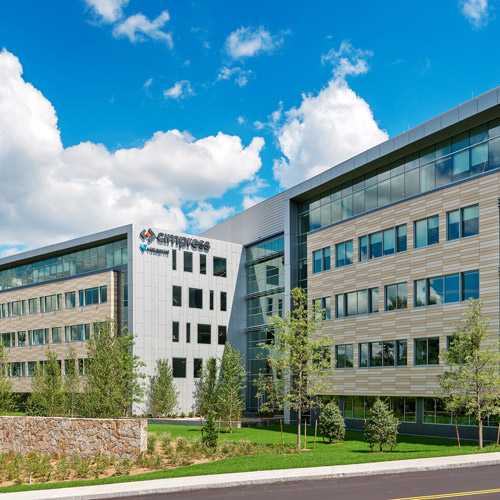In his eight years in corporate real estate, Mike Fithian can’t recall working on a single building project that didn’t have sustainability measures as part of the plan. So when he was placed at the head of the Daimler Group’s new headquarters project, he already had a strong sense of what was expected.
“We’re very much on the forefront of sustainability as a company, so our buildings should integrate it as well,” Fithian says. “It’s very important to me to bring those ideas forward to our company.”
He started his career in architecture—office interior work for Fortune 500 companies, to be specific. He soon came to realize his strengths in project management, but then the 2008 recession hit the industry hard. He watched the firm at which he worked shrink from approximately 200 employees to only 40 before getting out himself, opting instead for a position at an international project management firm. There, he was able to fine-tune his ability to manage all different facets of building design. It also introduced him to the world of corporate real estate.
“Working with attorneys, facilitating the buying and negotiation of leased properties and sale properties . . . I discovered I very much liked that aspect of the business,” Fithian recalls.
When he was assigned a multiyear contract involving Mercedes-Benz, his efforts made such an impression that Daimler Real Estate (the German-based parent company of Mercedes-Benz) snared him for a position it had available in the United States to handle NAFTA real estate issues. Four years later, his work covers Mercedes-Benz, Daimler trucks, and other Daimler entities that involve US corporate real estate.
As the Daimler presence in the United States grew, so did the need for a new US headquarters. After spending decades in northern New Jersey, a decision was made to relocate the entire facility to the Atlanta suburb of Sandy Springs, Georgia.
“I don’t think there was ever one overarching reason for leaving,” Fithian says of the decision. “It was a combination of many different things, including the cost of living in New Jersey being very high. We also have a manufacturing plant in Tuscaloosa, Alabama, so relocating to Sandy Springs puts us closer to that.”
From a building and design perspective, the move brings this particular Daimler facility into the 21st century as well. Dubbed “Project Eagle,” the move started with a temporary facility in Dunwoody, another Atlanta suburb, while building on the permanent location will continue through early 2018.
When it comes to laying out the workplace, efficiency is key—as is the need for contemporary, open collaboration areas.

“Employees were used to working a certain way in New Jersey—they had large 8-by-10-foot workstations,” Fithian says. “They were far from efficient, and required lots of real estate that was not needed . . . so we’re departing from all that.” He adds that the company seeks relatively compact, traditional office space for each employee, but says there will be a dedicated space for each in the open area as well.
“The transition space has become a place to test-drive our design and planning ideas,” Fithian says. “We get feedback on what works and what doesn’t, which will only go on to make our new permanent headquarters that much more of a success.”
He also says LEED certification is a definite goal for the Sandy Springs location. To that end, a LEED consultant is part of Project Eagle’s core team. Fithian is honing in on elements such as daylight-sensing systems and LED lighting, sustainable façade materials, and salvaged and/or recycled wood for the interiors. Also, once the 12-acre wooded lot the company purchased is cleared of trees, he wants to donate the majority of those trees to Atlanta organizations.

“If an idea [for sustainable building] makes sense, and we can include it in the budget, nine times out of 10 we’ll consider it,” he says.
Whether it’s about harvesting rain from the site’s large retention pond for landscape maintenance, or offering a proliferation of bike racks for employees who transport via two wheels instead of four—as well as charging stations for those who drive electric—Fithian expects the entire Sandy Springs campus to reflect an overall smaller carbon footprint in some way, shape, or form when completed.
“We’re pushing a little further with the sustainability whenever possible,” he says. “We certainly understand what those variables are, and what those costs are. . . . That’s definitely one of our key targets as part of the design of the building.”
 GAINING INSIGHT
GAINING INSIGHT
with Guest Editor Tom Ruscitti
TR: How has your education and training as an architect differentiated you from those in similar corporate real estate roles?
MF: My training and education provides me with a broader outlook and understanding on topics and projects in my real estate role. No two days are the same and you must wear many hats in our industry.
TR: At what point in your career trajectory did you decide to not practice architecture in a traditional sense?
MF: In the midst of my early architectural career in New York City, a friend and mentor of mine told me prior to my walking into a job pitch: “Don’t outsmart your common sense—be yourself.” Soon thereafter, I quickly realized how to apply my natural talents in anything I do in life, allowing me to excel in my chosen career paths.
TR: If you could do it over, would you study architecture?
MF: Absolutely. Architecture provides a strong foundation. Like anything in life, it’s what you make of it. There are so many doors (no pun intended), but they don’t open themselves.
TR: What lessons did you take away from the highly publicized relocation of Daimler’s US headquarters?
MF: Double checking is good. Triple checking is best.
TR: In what way did the ultra-recognizable Mercedes-Benz brand influence the design and aesthetic of the new headquarters?
MF: Like our cars, oftentimes the real beauty is what’s inside.
 GAINING INSIGHT
GAINING INSIGHT

